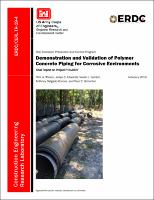Please use this identifier to cite or link to this item:
https://hdl.handle.net/11681/32320| Title: | Demonstration and validation of polymer concrete piping for corrosive environments : final report on Project F14-AR07 |
| Authors: | Wilson, Clint A. Edwards, Jaclyn S. Lamkin, Sarah L. Simonton, Paul C. Delgado-Connor, Anthony |
| Keywords: | Military bases Pipe, Concrete Sewerage Corrosion and anti-corrosives Polymer-impregnated concrete--Evaluation Polymer concrete piping (PCP) |
| Publisher: | Construction Engineering Research Laboratory (U.S.) Engineer Research and Development Center (U.S.) |
| Series/Report no.: | Technical Report (Engineer Research and Development Center (U.S.)) ; no. ERDC/CERL TR-19-4 |
| Abstract: | Sewer pipes and structures that convey aggressive wastewaters or are exposed to aggressive soil types can rapidly deteriorate, leading to premature leakage and service failure. This problem impacts mission execution on U.S. military installations by creating operational disruptions that require unplanned emergency repairs, increasing operational costs and reducing infrastructure service life. An emerging alternate material, polymer concrete, is made with high-strength resins and aggregates that have excellent resistance to corrosive factors inside and out as compared with standard concrete. Polymer concrete also has relatively high compressive, tensile, shear, and flexural strengths compared to ordinary concrete. This report documents a field demonstration of a polymer concrete pipe (PCP) structure measuring 24 in. diameter by approximately 200 linear feet, including seven manholes and two junction boxes. Performance was monitored through coupon testing in the wet well and in the laboratory. Results indicate that PCP is significantly more resistant to sulfuric acid than Portland cement concrete. PCP is relatively new to wastewater applications, so extra attention is needed during acquisition because practices recommended by polymer concrete manufacturers may differ from those used in conventional wastewater infrastructure projects. The calculated return on investment for this project is 9.27. |
| Description: | Technical Report |
| Gov't Doc #: | ERDC/CERL TR-19-4 |
| Rights: | Approved for Public Release; Distribution is Unlimited |
| URI: | https://hdl.handle.net/11681/32320 http://dx.doi.org/10.21079/11681/32320 |
| Appears in Collections: | Technical Report |
Files in This Item:
| File | Description | Size | Format | |
|---|---|---|---|---|
| ERDC-CERL TR-19-4.pdf | 17.4 MB | Adobe PDF |  View/Open |